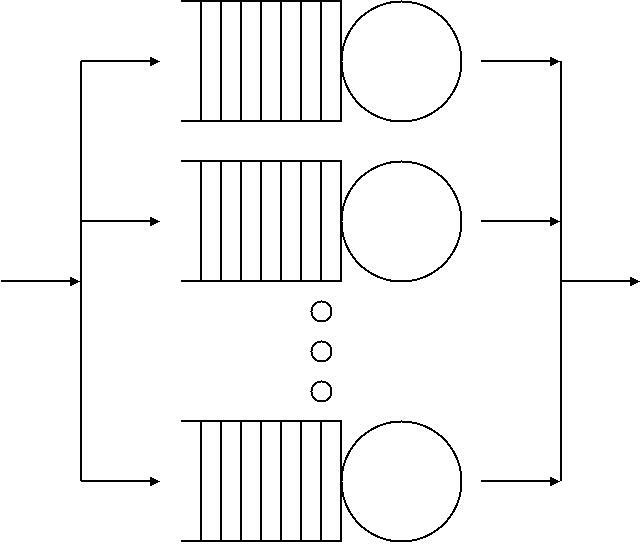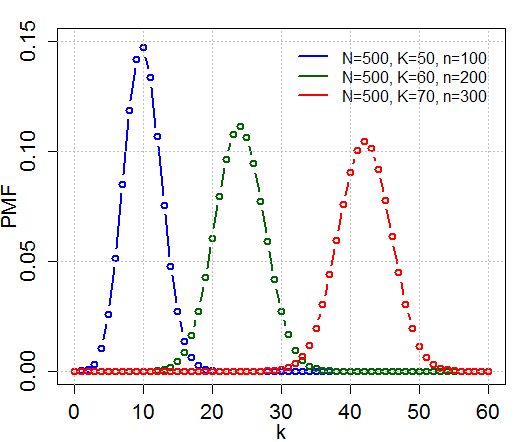|
Discrete Phase-type Distribution
The discrete phase-type distribution is a probability distribution that results from a system of one or more inter-related geometric distributions occurring in sequence, or phases. The sequence in which each of the phases occur may itself be a stochastic process. The distribution can be represented by a random variable describing the time until absorption of an absorbing Markov chain with one absorbing state. Each of the states of the Markov chain represents one of the phases. It has continuous time equivalent in the phase-type distribution. Definition A terminating Markov chain is a Markov chain where all states are transient, except one which is absorbing. Reordering the states, the transition probability matrix of a terminating Markov chain with m transient states is : =\left begin&\mathbf^0\\\mathbf^\mathsf&1\end\right where is a m\times m matrix, \mathbf^0 and \mathbf are column vectors with m entries, and \mathbf^0+\mathbf=\mathbf. The transition matrix is characterized ... [...More Info...] [...Related Items...] OR: [Wikipedia] [Google] [Baidu] |
Geometric Distribution
In probability theory and statistics, the geometric distribution is either one of two discrete probability distributions: * The probability distribution of the number ''X'' of Bernoulli trials needed to get one success, supported on the set \; * The probability distribution of the number ''Y'' = ''X'' − 1 of failures before the first success, supported on the set \. Which of these is called the geometric distribution is a matter of convention and convenience. These two different geometric distributions should not be confused with each other. Often, the name ''shifted'' geometric distribution is adopted for the former one (distribution of the number ''X''); however, to avoid ambiguity, it is considered wise to indicate which is intended, by mentioning the support explicitly. The geometric distribution gives the probability that the first occurrence of success requires ''k'' independent trials, each with success probability ''p''. If the probability of suc ... [...More Info...] [...Related Items...] OR: [Wikipedia] [Google] [Baidu] |
Discrete Distributions
Discrete may refer to: *Discrete particle or quantum in physics, for example in quantum theory *Discrete device, an electronic component with just one circuit element, either passive or active, other than an integrated circuit *Discrete group, a group with the discrete topology *Discrete category, category whose only arrows are identity arrows *Discrete mathematics, the study of structures without continuity *Discrete optimization, a branch of optimization in applied mathematics and computer science *Discrete probability distribution, a random variable that can be counted *Discrete space, a simple example of a topological space *Discrete spline interpolation, the discrete analog of ordinary spline interpolation *Discrete time, non-continuous time, which results in discrete-time samples *Discrete variable In mathematics and statistics, a quantitative variable may be continuous or discrete if they are typically obtained by ''measuring'' or ''counting'', respectively. If it c ... [...More Info...] [...Related Items...] OR: [Wikipedia] [Google] [Baidu] |
Queueing Theory
Queueing theory is the mathematical study of waiting lines, or queues. A queueing model is constructed so that queue lengths and waiting time can be predicted. Queueing theory is generally considered a branch of operations research because the results are often used when making business decisions about the resources needed to provide a service. Queueing theory has its origins in research by Agner Krarup Erlang when he created models to describe the system of Copenhagen Telephone Exchange company, a Danish company. The ideas have since seen applications including telecommunication, traffic engineering, computing and, particularly in industrial engineering, in the design of factories, shops, offices and hospitals, as well as in project management. Spelling The spelling "queueing" over "queuing" is typically encountered in the academic research field. In fact, one of the flagship journals of the field is ''Queueing Systems''. Single queueing nodes A queue, or queueing no ... [...More Info...] [...Related Items...] OR: [Wikipedia] [Google] [Baidu] |
Phase-type Distribution
A phase-type distribution is a probability distribution constructed by a convolution or mixture of exponential distributions. It results from a system of one or more inter-related Poisson processes occurring in sequence, or phases. The sequence in which each of the phases occurs may itself be a stochastic process. The distribution can be represented by a random variable describing the time until absorption of a Markov process with one absorbing state. Each of the states of the Markov process represents one of the phases. It has a discrete-time equivalent the discrete phase-type distribution. The set of phase-type distributions is dense in the field of all positive-valued distributions, that is, it can be used to approximate any positive-valued distribution. Definition Consider a continuous-time Markov process with ''m'' + 1 states, where ''m'' ≥ 1, such that the states 1,...,''m'' are transient states and state 0 is an absorbing state. Further, let the ... [...More Info...] [...Related Items...] OR: [Wikipedia] [Google] [Baidu] |
Hypergeometric Distribution
In probability theory and statistics, the hypergeometric distribution is a discrete probability distribution that describes the probability of k successes (random draws for which the object drawn has a specified feature) in n draws, ''without'' replacement, from a finite population of size N that contains exactly K objects with that feature, wherein each draw is either a success or a failure. In contrast, the binomial distribution describes the probability of k successes in n draws ''with'' replacement. Definitions Probability mass function The following conditions characterize the hypergeometric distribution: * The result of each draw (the elements of the population being sampled) can be classified into one of two mutually exclusive categories (e.g. Pass/Fail or Employed/Unemployed). * The probability of a success changes on each draw, as each draw decreases the population ('' sampling without replacement'' from a finite population). A random variable X follows the hype ... [...More Info...] [...Related Items...] OR: [Wikipedia] [Google] [Baidu] |
Hyperexponential Distribution
In probability theory, a hyperexponential distribution is a continuous probability distribution whose probability density function of the random variable ''X'' is given by : f_X(x) = \sum_^n f_(x)\;p_i, where each ''Y''''i'' is an exponentially distributed random variable with rate parameter ''λ''''i'', and ''p''''i'' is the probability that ''X'' will take on the form of the exponential distribution with rate ''λ''''i''. It is named the ''hyper''exponential distribution since its coefficient of variation is greater than that of the exponential distribution, whose coefficient of variation is 1, and the hypoexponential distribution, which has a coefficient of variation smaller than one. While the exponential distribution is the continuous analogue of the geometric distribution, the hyperexponential distribution is not analogous to the hypergeometric distribution. The hyperexponential distribution is an example of a mixture density. An example of a hyperexponential random variabl ... [...More Info...] [...Related Items...] OR: [Wikipedia] [Google] [Baidu] |
Negative Binomial Distribution
In probability theory Probability theory is the branch of mathematics concerned with probability. Although there are several different probability interpretations, probability theory treats the concept in a rigorous mathematical manner by expressing it through a set o ... and statistics, the negative binomial distribution is a discrete probability distribution that models the number of failures in a sequence of independent and identically distributed Bernoulli trials before a specified (non-random) number of successes (denoted r) occurs. For example, we can define rolling a 6 on a die as a success, and rolling any other number as a failure, and ask how many failure rolls will occur before we see the third success (r=3). In such a case, the probability distribution of the number of failures that appear will be a negative binomial distribution. An alternative formulation is to model the number of total trials (instead of the number of failures). In fact, for a specified (non-ra ... [...More Info...] [...Related Items...] OR: [Wikipedia] [Google] [Baidu] |
Degenerate Distribution
In mathematics, a degenerate distribution is, according to some, a probability distribution in a space with support only on a manifold of lower dimension, and according to others a distribution with support only at a single point. By the latter definition, it is a deterministic distribution and takes only a single value. Examples include a two-headed coin and rolling a die whose sides all show the same number. This distribution satisfies the definition of "random variable" even though it does not appear random in the everyday sense of the word; hence it is considered degenerate. In the case of a real-valued random variable, the degenerate distribution is a one-point distribution, localized at a point ''k''0 on the real line. The probability mass function equals 1 at this point and 0 elsewhere. The degenerate univariate distribution can be viewed as the limiting case of a continuous distribution whose variance goes to 0 causing the probability density function to be a delta ... [...More Info...] [...Related Items...] OR: [Wikipedia] [Google] [Baidu] |
Stochastic Process
In probability theory and related fields, a stochastic () or random process is a mathematical object usually defined as a family of random variables. Stochastic processes are widely used as mathematical models of systems and phenomena that appear to vary in a random manner. Examples include the growth of a bacterial population, an electrical current fluctuating due to thermal noise, or the movement of a gas molecule. Stochastic processes have applications in many disciplines such as biology, chemistry, ecology, neuroscience, physics, image processing, signal processing, control theory, information theory, computer science, cryptography and telecommunications. Furthermore, seemingly random changes in financial markets have motivated the extensive use of stochastic processes in finance. Applications and the study of phenomena have in turn inspired the proposal of new stochastic processes. Examples of such stochastic processes include the Wiener process or Brownian motion ... [...More Info...] [...Related Items...] OR: [Wikipedia] [Google] [Baidu] |
Identity Matrix
In linear algebra, the identity matrix of size n is the n\times n square matrix with ones on the main diagonal and zeros elsewhere. Terminology and notation The identity matrix is often denoted by I_n, or simply by I if the size is immaterial or can be trivially determined by the context. I_1 = \begin 1 \end ,\ I_2 = \begin 1 & 0 \\ 0 & 1 \end ,\ I_3 = \begin 1 & 0 & 0 \\ 0 & 1 & 0 \\ 0 & 0 & 1 \end ,\ \dots ,\ I_n = \begin 1 & 0 & 0 & \cdots & 0 \\ 0 & 1 & 0 & \cdots & 0 \\ 0 & 0 & 1 & \cdots & 0 \\ \vdots & \vdots & \vdots & \ddots & \vdots \\ 0 & 0 & 0 & \cdots & 1 \end. The term unit matrix has also been widely used, but the term ''identity matrix'' is now standard. The term ''unit matrix'' is ambiguous, because it is also used for a matrix of ones and for any unit of the ring of all n\times n matrices. In some fields, such as group theory or quantum mechanics, the identity matrix is sometimes denoted by a boldface one, \mathbf, or called "id" (short for identity ... [...More Info...] [...Related Items...] OR: [Wikipedia] [Google] [Baidu] |


